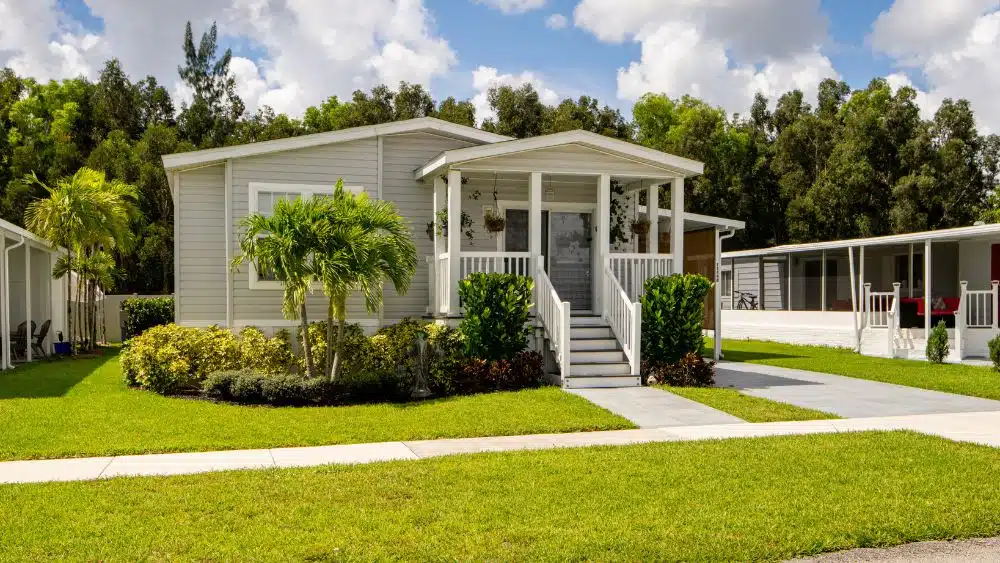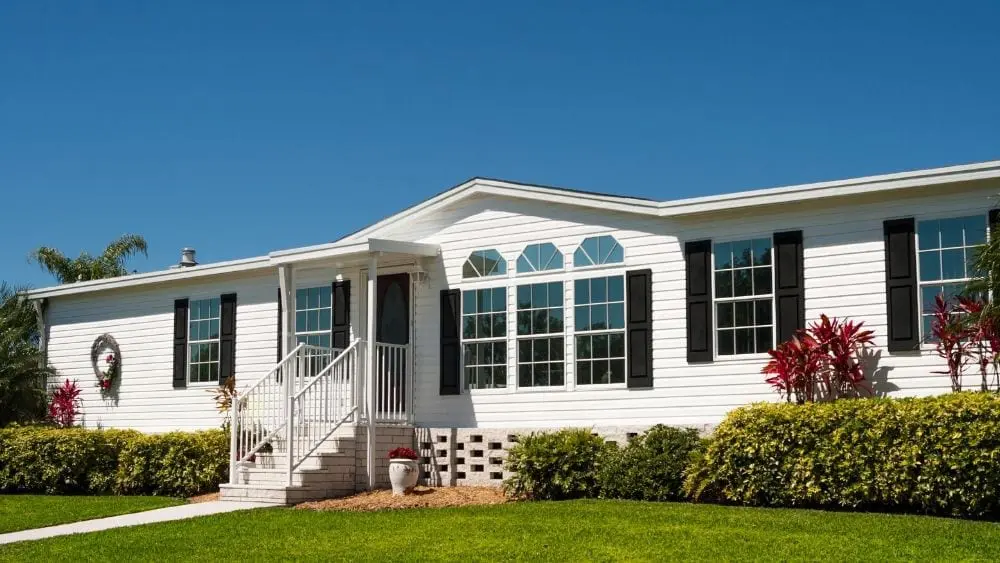
Manufactured homes have come a long way in both affordability and style! Buying a new manufactured home can be a smart and cost-effective option for potential new homebuyers looking to maximize their budget while still becoming homeowners. The affordability, combined with modern amenities and design options, make manufactured homes an appealing choice for many.
Hannah Raine and her husband, both in their early 20s, live in their dream home, and it surprises most people when they find out it is a manufactured house. When the couple first married, they bought her childhood home about an hour from Nashville in Mount Pleasant, Tennessee. Two years later, they purchased land from a nearby friend and planned to build a custom home on the property.
“We had the cash to buy the land when we sold our house, but we discovered building a custom home would take way more money than we had, and would take too long,” says Raine. “We were living on the property in a 26-foot linear camper with our 2-year-old, sharing a full-size bed.” An ad for the “Lulamae” manufactured home by Clayton captured her attention on Facebook and days later, the couple bought the model from a lot. “The house came in two pieces and two months later we moved in,” says Raine. “We had some weather delays; otherwise it would have been even faster.” Raine estimates the couple saved more than $100,000 by purchasing a manufactured home instead of building a home. The Lulamae model is priced from the $180,000s in Tennessee.
Clayton, which has 40 factories nationwide building manufactured and modular homes, sells manufactured homes with 1,200 to 2,400 square feet that are priced from affordably depending on the market, size of the home, and amenities. That price does not include the land where the home will reside on, but it is normally well below the sales price of $524,800 in March 2024, according to the Census Bureau.
In 2022, the manufactured housing industry witnessed the production of 112,882 new homes, accounting for approximately 11% of new single-family home starts. During the same year, the average sales price of a new manufactured home, excluding land, was $127,250 according to the Manufactured Housing Institute (MHI).
Advantages of Manufactured Homes
Manufactured homes are generally more affordable than traditional stick-built houses due to the efficiencies of factory production. Homes are built in controlled environments, reducing costs related to weather delays and on-site labor. Materials are bought in bulk, and the assembly-line process reduces waste and increases efficiency. This can result in substantial savings for the buyer, with many finding that manufactured homes offer more square footage and amenities for their money compared to what they would spend on a traditional home..
One of the key benefits of a manufactured home is the speed of construction. A manufactured home can be built and installed within a matter of weeks, unlike traditional homes which can take months or even years. Additionally, these homes must meet federal HUD Code regulations, which ensure they are built to certain safety standards.
Many new manufactured homes are also designed with energy efficiency in mind, equipped with eco-friendly materials and appliances. This not only helps the environment but can also save homeowners money on utility bills. The tight construction in factories helps improve the home’s thermal performance, making heating and cooling more efficient than in many traditionally built homes.
Design-Forward Manufactured Homes

While a lower price and a faster completion date are welcome, buyers also want a house that reflects their taste and lifestyle. Today’s manufactured homes offer numerous stylish features that can rival those of traditional homes.
Modern manufactured homes can include luxury amenities such as granite countertops, hardwood flooring, large master suites, and high-end appliances. They also feature contemporary designs with open floor plans, large windows that bring in natural light, and higher ceilings. In recent years, technological improvements have made it easier for manufactured homes to be built with open floor plans and higher ceilings, rather than the boxy designs that were initially associated with off-site built homes.
Exterior designs can be enhanced with porches, decking, and landscaping to increase curb appeal. While an attainable price is a prime factor in the popularity of manufactured homes, technology, and design innovations contribute to their value.
Clayton recently opened a design center where architects, engineers, and interior designers can collaborate using virtual reality during the design process where floor plans are representative of different generations and lifestyles. With the use of virtual reality, you can see structural changes and tweak materials to envision your new home. Clayton’s interior design team includes researchers who stay current on the colors, textures, materials and designs that appeal to buyers including everything from farmhouse style to modern looks.
With options like larger islands and accent walls, manufactured homes have the features that personalize your new home to your needs. Manufactured homes offer a level of customization that allows buyers to tailor their living space to their needs and tastes without the premium price tag of custom traditional construction. Buyers can choose from a variety of floor plans and design options to suit their lifestyle and preferences.
Buyers can personalize their manufactured home with design center choices, but Raine and her husband found that the Lulamae model matched their priorities. The Raine’s 1,832-square-foot farmhouse-style home has three bedrooms and two bathrooms. The Raine’s master suite has a walk-in closet and a large bathroom with double vanities, a freestanding garden tub, and a large shower.
“The details of the home and the character we wanted were already there,” says Raine. “My husband is a contractor, so he recognized the quality of the home right away. It’s built with 2-by-6s instead of 2-by-4s, for example. I’ve featured our house on Instagram and people think it’s a $500,000 house,” she says. “I love that it has real shiplap walls, a big farmhouse kitchen with a farmhouse sink, wood counters, white cabinets and tray ceilings.”
An important priority for many buyers today that Clayton addresses is storage. Many designs are mindful and utilize space efficiently with features like pantries, versatile laundry room, cabinetry, and open shelving. Features such as keyless entry, smart thermostats, energy-efficient heating and air conditioning, oversized closets, covered porches, and outdoor living spaces are other perks of buying a manufactured home.
Tips for Buying an Off-Site Built Home
To find a builder for manufactured or modular homes, search in your preferred location at NewHomeSource.com to peruse options and floor plans. Plan a visit to an manufactured home center to see models, amenities, and colors. Know your price point and key features that are important to your lifestyle.
Financing and Value in Manufactured Homes
Manufactured homes can be financed like traditionally built homes as long as they are attached to a permanent site and meet construction criteria. Growing acceptance of off-site built homes is evident in their rate of appreciation. According to the Urban Institute, the value of off-site built homes increased at an average national growth rate of 3.4 percent, nearly the same rate as onsite-built homes, which have an average annual growth rate of 3.8 percent.
Environmental and Energy Efficiency
Many new manufactured homes are also designed with energy efficiency in mind, equipped with eco-friendly materials and appliances. This not only helps the environment but can also save homeowners money on utility bills. The tight construction in factories helps improve the home’s thermal performance, making heating and cooling more efficient than in many traditionally built homes.
Flexibility and Customization
Manufactured homes offer a level of customization that allows buyers to tailor their living space to their needs and tastes without the premium price tag of custom traditional construction. Buyers can choose from a variety of floor plans and design options to suit their lifestyle and preferences.
For potential homebuyers looking at getting the most value for their investment, a new manufactured home presents a compelling option. The combination of affordability, style, and modern amenities makes it a worthy consideration for anyone entering the housing market.

Michele Lerner is an award-winning freelance writer, editor and author who has been writing about real estate, personal finance and business topics for more than two decades.
 Kitchen and Bath Experts Reveal Flooring Trends
Kitchen and Bath Experts Reveal Flooring Trends